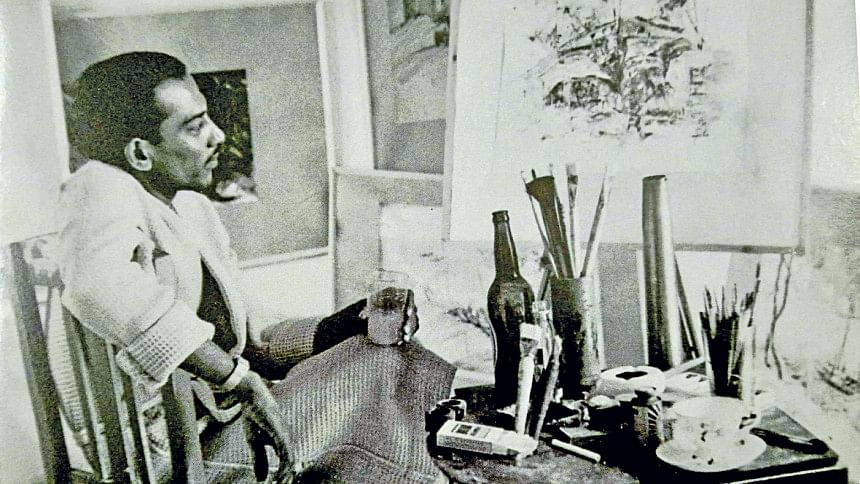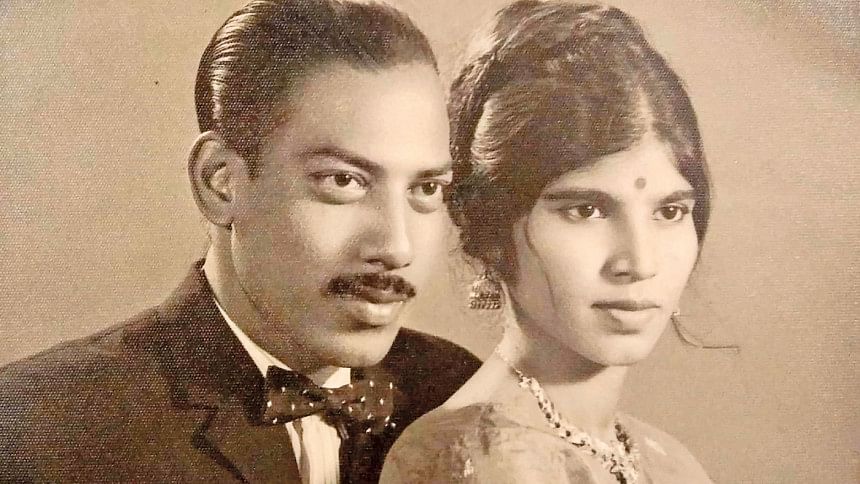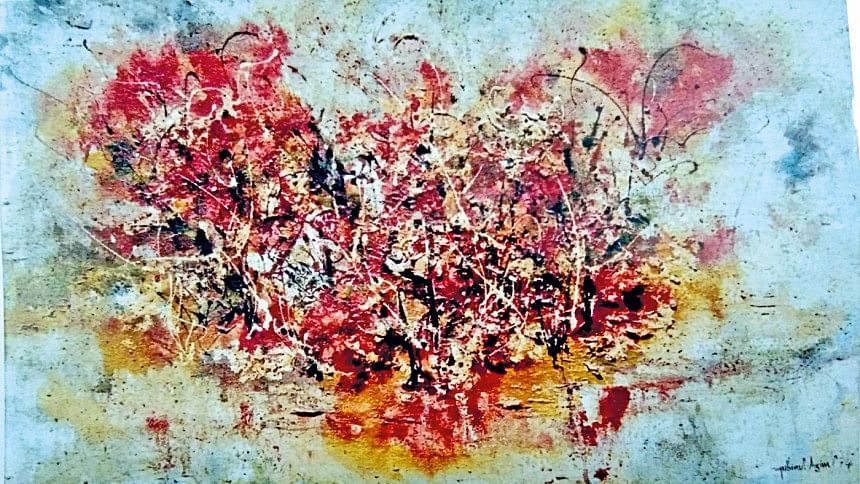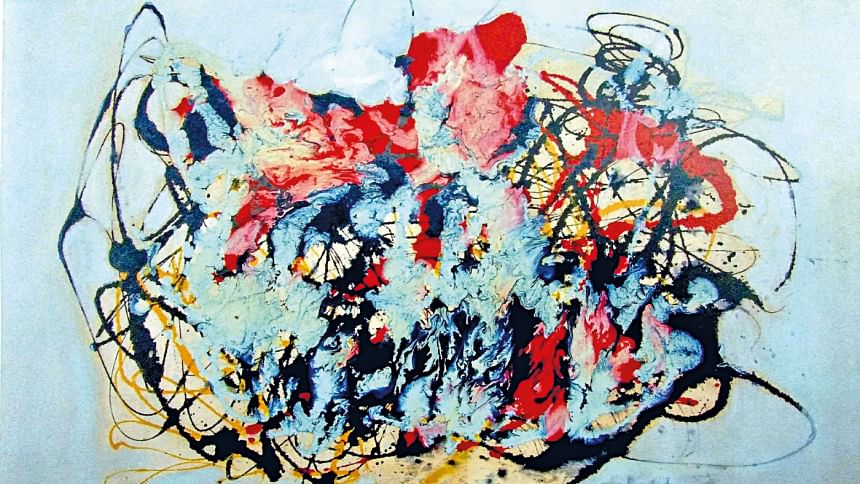Remembering legendary artist Mubinul Azim

The modern art movement in Bangladesh, which started in the early 20th century, gave birth to multiple pioneering artists, gaining Bangladeshi art international recognition. One of the pioneers of modern art in Bangladesh, Mubinul Azim, enriched the Bangladeshi art scenario through his brilliant creations, along with other pioneering legends.
Born on November 24, 1934, Mubinul Azim passed away in 1975, at the age of 41. Marking the legendary painter's 45th death anniversary on November 1, The Daily Star caught up with Momtaz Azim, widow of Mubinul Azim, as she reminisces countless anecdotes about her late husband.

Despite his short span of life, Mubinul Azim presented the world with a treasure trove of creations, starting from sketches, oil paints, watercolours to experimenting with various materials, nylon, cement, sand, jute and clothes among others. "He used to love experimenting with different materials and loved to create various artworks with unconventional materials," shared Momtaz Azim.
A second-year student at the Dacca Art College (at present Faculty of Fine Art, University of Dhaka) in 1952, Azim was an active participant of the Language Movement, organizing protests and producing several posters and paintings of the time.

Passionate about painting from his childhood, Azim was a direct student of Shilpacharya Zainul Abedin and later was given a stature next to the legendary artist upon his brilliance. "He was addicted to painting since childhood and as an artist, he had a completely different world of his own," shared Momtaz Azim.
The 1950-1960 time frame was the most revolutionary for modern and contemporary Bangladeshi artists, around the time, Azim along with other counterparts introduced various forms of modern, abstract, abstract-impressionist and abstract-expressionist art. Azim was considered a prominent and pioneering artist of Pakistan at the time.
Azim's career as a painter started when he moved to Karachi in 1957, where he worked as a teacher at an art institution and later in the Alliance Francaise Karachi, he also worked as a lecturer at Pak-American Centre in Karachi, Pakistan.
Azim had an intricate and individualistic style of painting, his exceptional styling of colour treatment and composition, continues to mesmerise aesthetes till now. Brilliant in design and texture, nature and its various elements found their way into Azim's canvas, with unique, bright colours and forms. Passionate about intrinsic details, Azim also constructed artistic impressions of modern life and portrayed them with elegance. The charm and bitterness, the appeal and longings and other different aspects of city and country life came alive in his canvas.
Mubinul Azim's brilliant creations made him a favourite among the elites and high officials of Pakistan, several of his works were portrayed in official buildings including a portrait of Quaid-I-Azam in the National Parliament.

In 1964, the former Pakistan president Ayub Khan presented King Birendra of Nepal, a painting by Mubinul Azim. "The painting mesmerised the King and he later invited Mubin to visit Nepal, but unfortunately the trip never happened," shared Mrs Azim.
After the Liberation War, Azim returned to Dhaka for good and completely immersed himself in the world of art. Azim painted three portraits of Bangabandhu Sheikh Mujibur Rahman, one of them found its way into Prime Minister Sheikh Hasina's personal collection.
Bangabandhu Sheikh Mujibur Rahman presented the renowned BBC journalist, Sir William Mark Tully, reputed for his coverage of the Liberation War, a painting by Mubinul Azim in 1974, as a gesture of appreciation.
Throughout his career, Azim held 17 solo exhibitions and 37 group art exhibitions in the country and abroad. In his honour, three solo exhibitions were arranged at Dhaka Club (1976), Bangladesh Shilpakala Academy (1998) and Bengal Art Gallery (2015).
Shortly after his demise, Dhaka Club, along with noted singer Kalim Sharafi and others, hosted an event commemorating Mubinul Azim and his life. In 2012, the painter was posthumously awarded Ekushey Padak for his outstanding contribution to Bangladeshi art.

In the book, "Mubinul Azim: Colours and Dreams," published by Bengal Publications, Momtaz Azim has persevered and documented his works, reports, articles and discussions on Azim and his works. Momtaz Azim's contributions and sacrifices have played an important role in Mubinul Azim's illustrious career and even after years of his demise, she continues to preserve and collect these valuable works of art.
Azim's paintings are showcased in several places including Bangladesh National Museum, Bangladesh Parjatan Corporation, Bangladesh Biman, Bangladesh Atomic Energy Commission, Bangladesh Bank, Jeddah Airport, Sonali Bank- London Branch and Dhaka Club among other monumental landmarks.
It was a huge loss for the new nation of Bangladesh, in 1975 to lose one of its most brilliant artists so early in life. Mubinul Azim's contribution to the art movement of Bangladesh has immortalised the late artist through his invaluable creations.

 For all latest news, follow The Daily Star's Google News channel.
For all latest news, follow The Daily Star's Google News channel. 



Comments